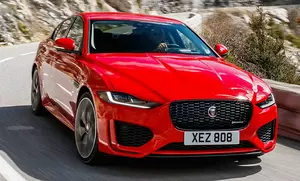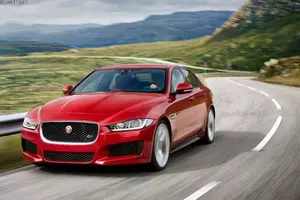
| Vehicle | Curb weight | Difference from world's smallest | Weight to power ratio | 0—60 mph acceleration ratio | Consumption ratio |
|---|---|---|---|---|---|
| D180 |
1610 kg / 3550 lbs |
1185 kg (2613 lbs) heavier | 9 kg to 1 hp | 201 kg/s (443 lbs/s) |
310 kg/L (684 lbs/L) |
| P250 |
1589 kg / 3504 lbs |
1164 kg (2567 lbs) heavier | 6 kg to 1 hp | 256 kg/s (564 lbs/s) | - |
| P300 |
1615 kg / 3561 lbs |
1190 kg (2624 lbs) heavier | 5 kg to 1 hp | 299 kg/s (659 lbs/s) |
221 kg/L (487 lbs/L) |
| Vehicle | D180 |
|---|---|
| Curb weight |
1610 kg / 3550 lbs |
| Difference from world's smallest | 1185 kg (1185 lbs) heavier |
| Weight to power ratio | 9 kg to 1 hp |
| 0—60 mph acceleration ratio | 201 kg/s (443 lbs/s) |
| Consumption ratio |
310 kg/L (684 lbs/L) |
| Vehicle | P250 |
| Curb weight |
1589 kg / 3504 lbs |
| Difference from world's smallest | 1164 kg (1164 lbs) heavier |
| Weight to power ratio | 6 kg to 1 hp |
| 0—60 mph acceleration ratio | 256 kg/s (564 lbs/s) |
| Consumption ratio | - |
| Vehicle | P300 |
| Curb weight |
1615 kg / 3561 lbs |
| Difference from world's smallest | 1190 kg (1190 lbs) heavier |
| Weight to power ratio | 5 kg to 1 hp |
| 0—60 mph acceleration ratio | 299 kg/s (659 lbs/s) |
| Consumption ratio |
221 kg/L (487 lbs/L) |

| Vehicle | Curb weight | Difference from world's smallest | Weight to power ratio | 0—60 mph acceleration ratio | Consumption ratio |
|---|---|---|---|---|---|
| 2.0d |
1650 kg / 3638 lbs |
1225 kg (2701 lbs) heavier | 7 kg to 1 hp | 284 kg/s (626 lbs/s) |
317 kg/L (699 lbs/L) |
| 2.0 |
1620 kg / 3572 lbs |
1195 kg (2635 lbs) heavier | 5 kg to 1 hp | 312 kg/s (688 lbs/s) |
235 kg/L (518 lbs/L) |
| 3.0 V6 |
1665 kg / 3671 lbs |
1240 kg (2734 lbs) heavier | 5 kg to 1 hp | 347 kg/s (765 lbs/s) |
206 kg/L (454 lbs/L) |
| S 3.0 |
1655 kg / 3649 lbs |
1230 kg (2712 lbs) heavier | 4 kg to 1 hp | 345 kg/s (761 lbs/s) |
204 kg/L (450 lbs/L) |
| SV Project 8 5.0 V8 |
1745 kg / 3848 lbs |
1320 kg (2911 lbs) heavier | 3 kg to 1 hp | 499 kg/s (1100 lbs/s) | - |
| Vehicle | 2.0d |
|---|---|
| Curb weight |
1650 kg / 3638 lbs |
| Difference from world's smallest | 1225 kg (1225 lbs) heavier |
| Weight to power ratio | 7 kg to 1 hp |
| 0—60 mph acceleration ratio | 284 kg/s (626 lbs/s) |
| Consumption ratio |
317 kg/L (699 lbs/L) |
| Vehicle | 2.0 |
| Curb weight |
1620 kg / 3572 lbs |
| Difference from world's smallest | 1195 kg (1195 lbs) heavier |
| Weight to power ratio | 5 kg to 1 hp |
| 0—60 mph acceleration ratio | 312 kg/s (688 lbs/s) |
| Consumption ratio |
235 kg/L (518 lbs/L) |
| Vehicle | 3.0 V6 |
| Curb weight |
1665 kg / 3671 lbs |
| Difference from world's smallest | 1240 kg (1240 lbs) heavier |
| Weight to power ratio | 5 kg to 1 hp |
| 0—60 mph acceleration ratio | 347 kg/s (765 lbs/s) |
| Consumption ratio |
206 kg/L (454 lbs/L) |
| Vehicle | S 3.0 |
| Curb weight |
1655 kg / 3649 lbs |
| Difference from world's smallest | 1230 kg (1230 lbs) heavier |
| Weight to power ratio | 4 kg to 1 hp |
| 0—60 mph acceleration ratio | 345 kg/s (761 lbs/s) |
| Consumption ratio |
204 kg/L (450 lbs/L) |
| Vehicle | SV Project 8 5.0 V8 |
| Curb weight |
1745 kg / 3848 lbs |
| Difference from world's smallest | 1320 kg (1320 lbs) heavier |
| Weight to power ratio | 3 kg to 1 hp |
| 0—60 mph acceleration ratio | 499 kg/s (1100 lbs/s) |
| Consumption ratio | - |